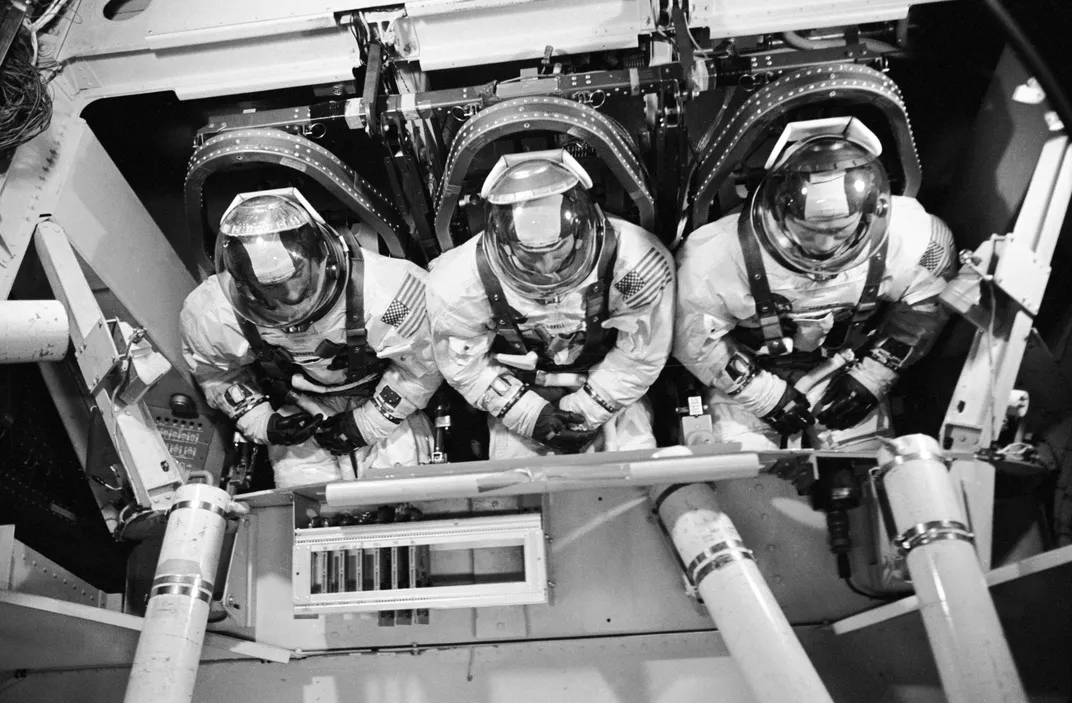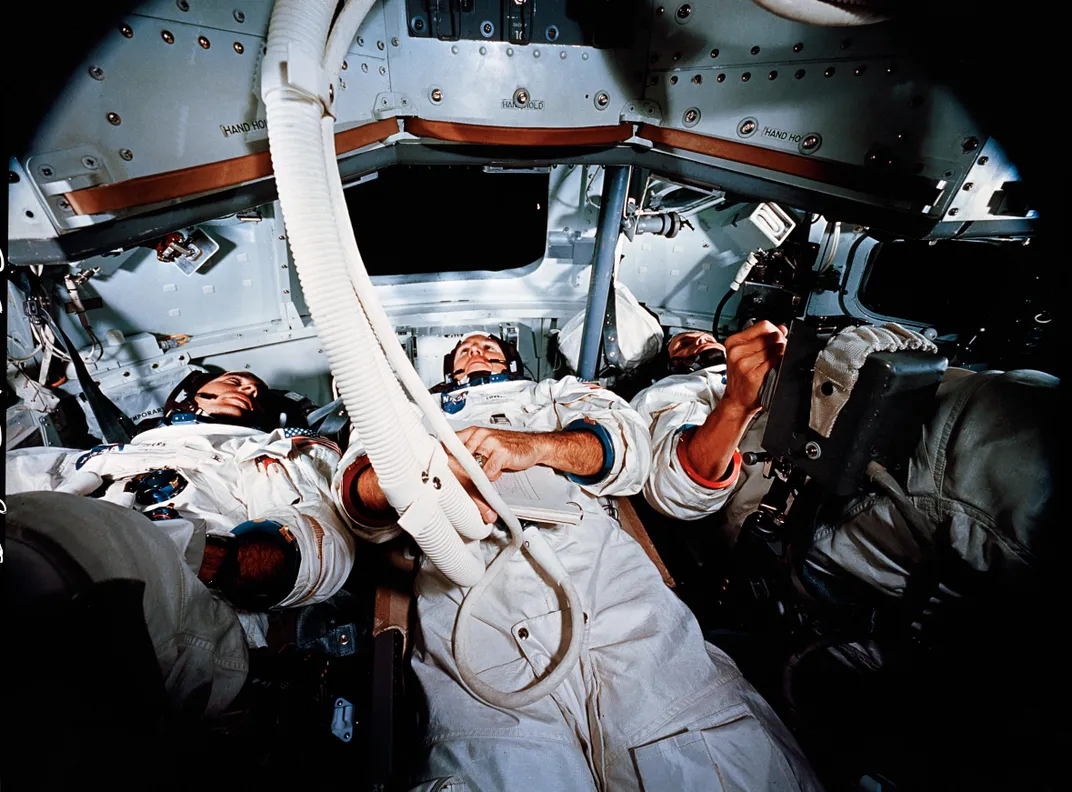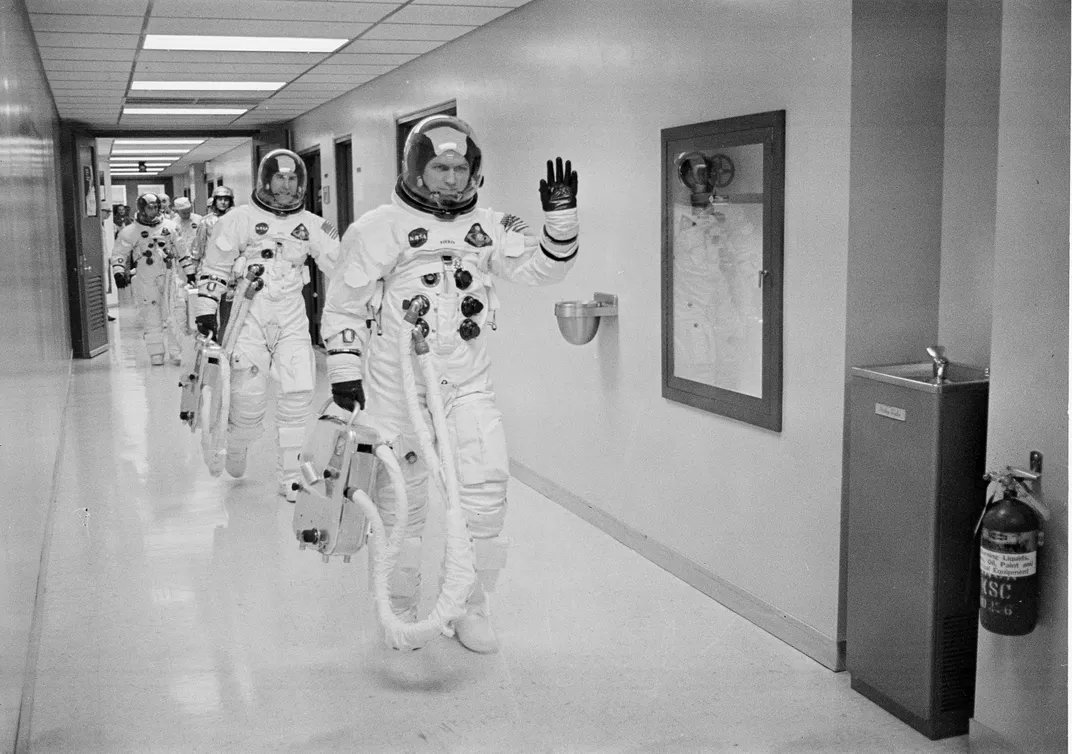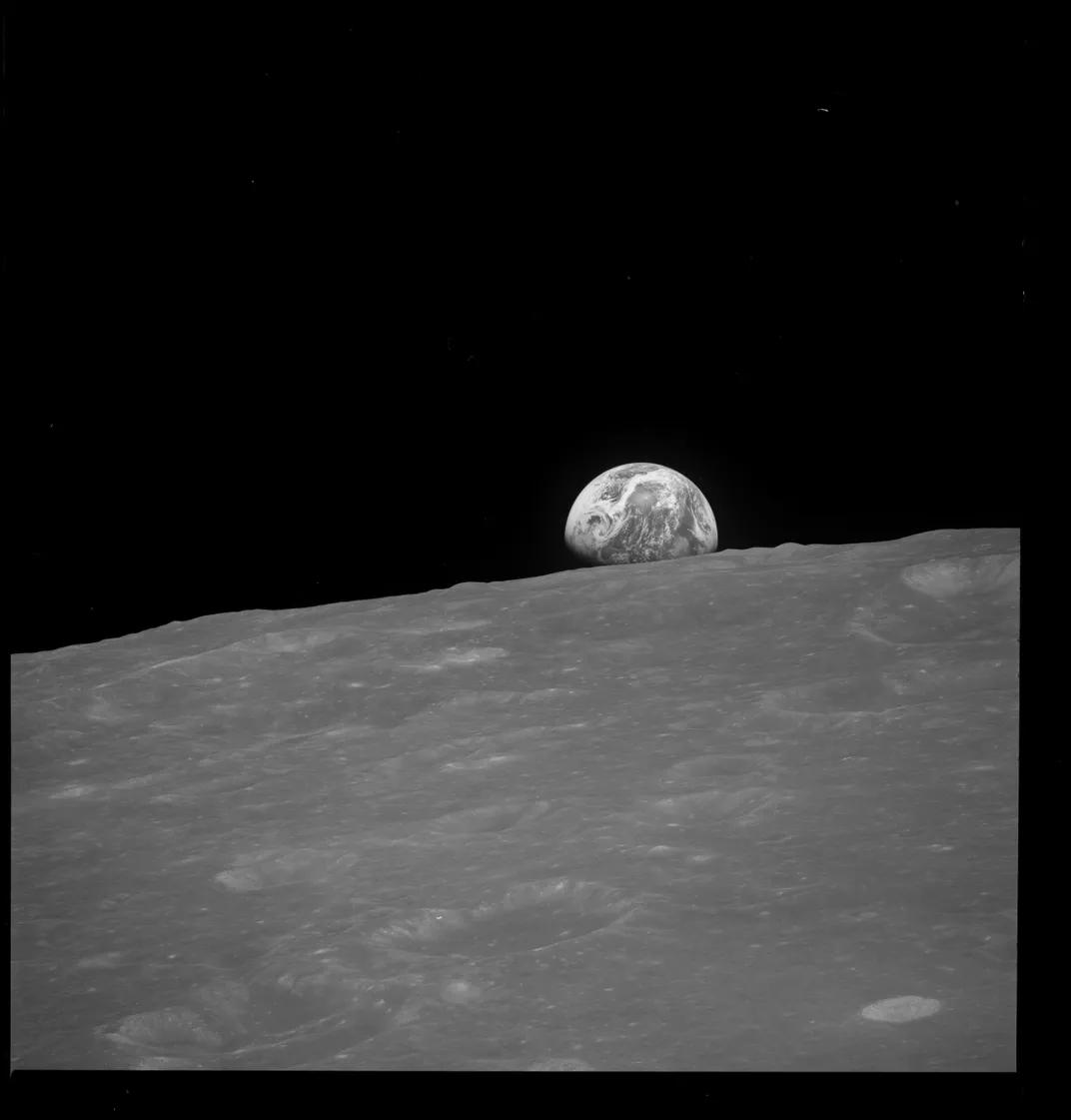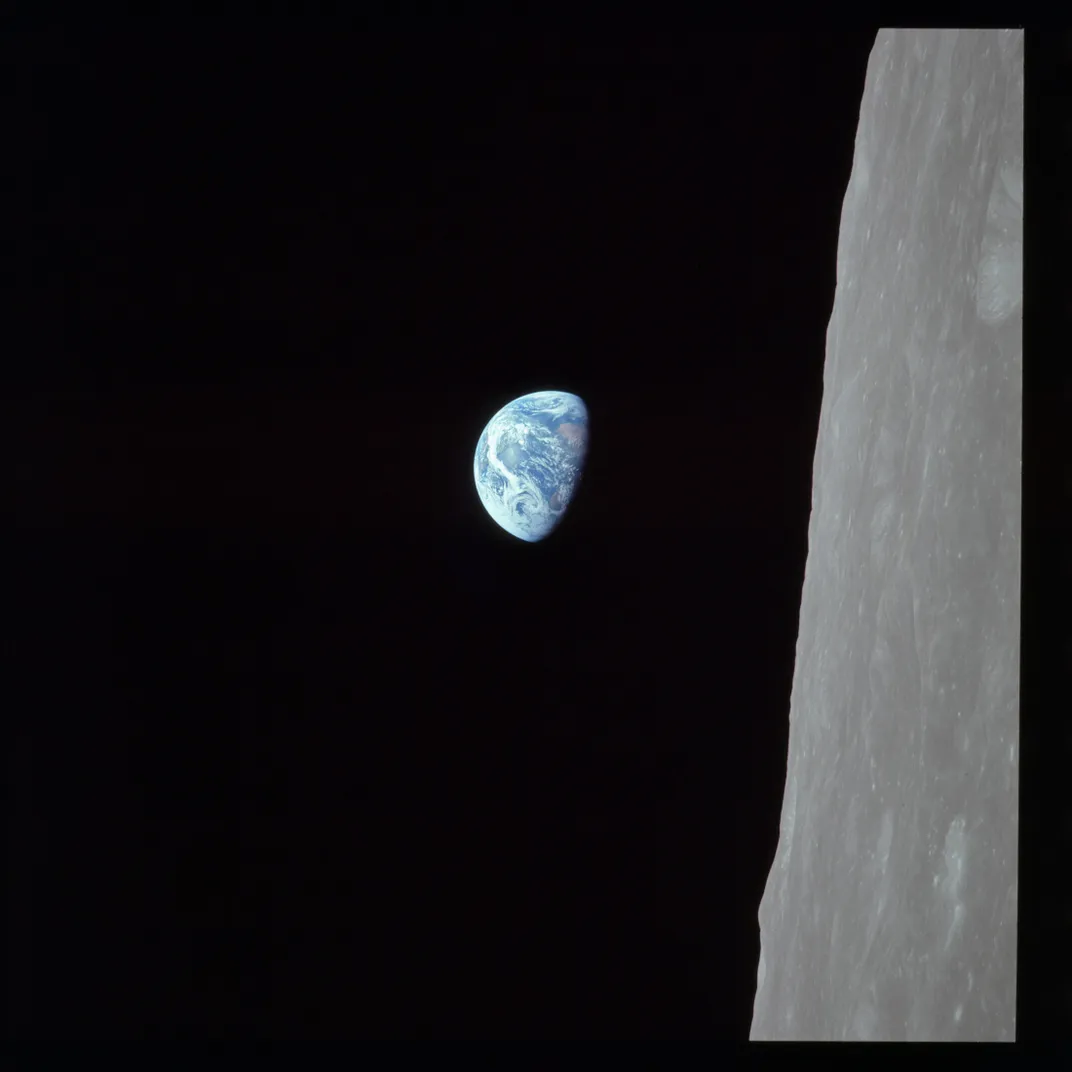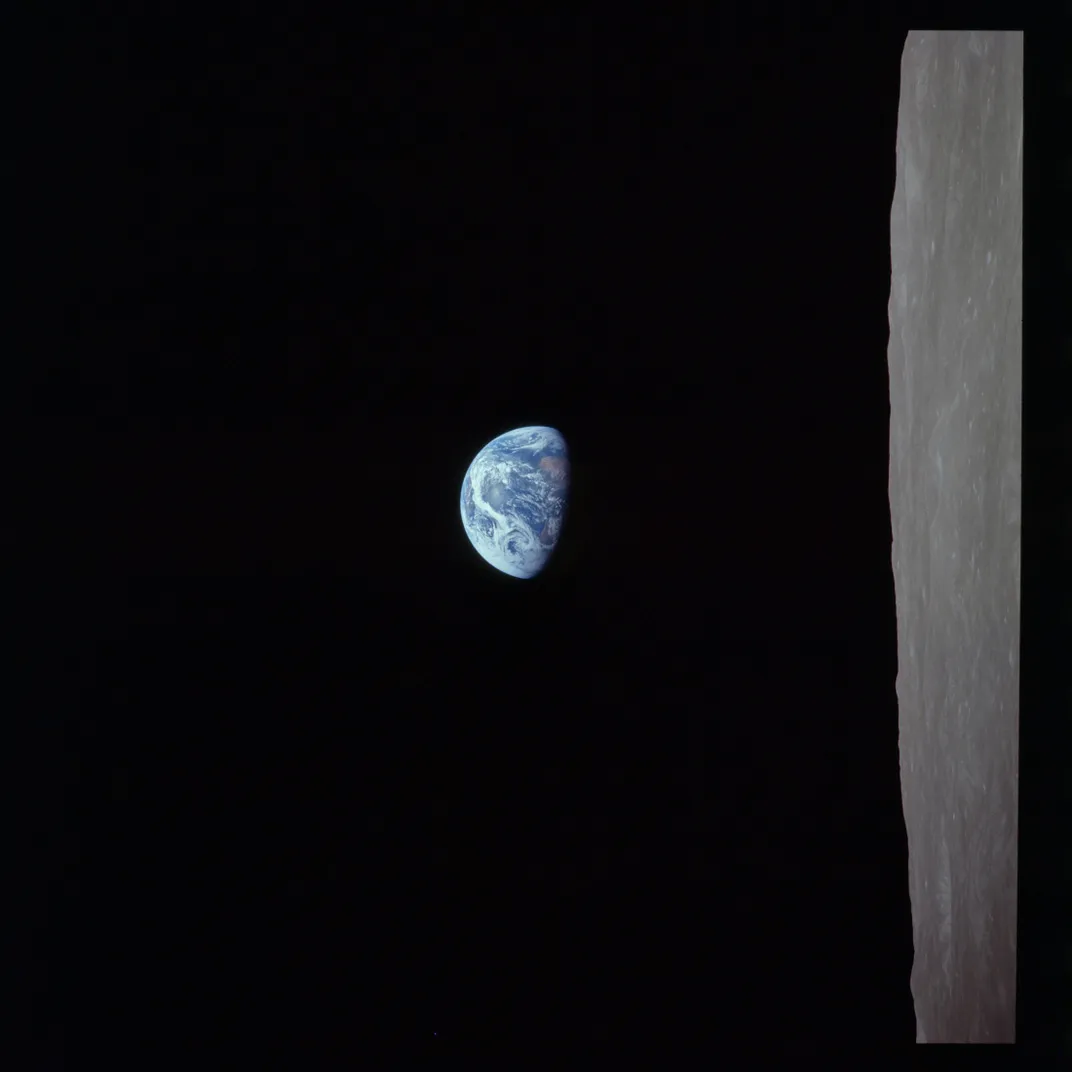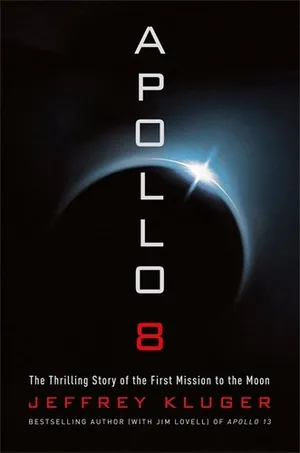Who Took the Legendary Earthrise Photo From Apollo 8?
The mission returned to Earth with one of the most famous images in history
/https://tf-cmsv2-smithsonianmag-media.s3.amazonaws.com/filer/30/bd/30bd875f-d639-43f8-8217-5fdd7d46e300/janfeb2018_l03_apollo8.jpg)
It’s arguably the most iconic photograph of the 20th century: the Earth rising above the Moon’s bleached and desolate horizon, a breathtaking jewel of color and life more than 230,000 miles away. In December 1968, Apollo 8 astronauts Frank Borman, Jim Lovell and Bill Anders returned from history’s first voyage around the Moon with this stunning image. In the following weeks, on newspaper front pages and magazine covers around the world, we suddenly saw ourselves as inhabitants of a lovely and seemingly tranquil planet afloat in the endless void of space.
In today’s visually bombarded world it’s hard to imagine the immediate, global impact of that single image. The picture that came to be known as “Earthrise” offered a precious moment of transcendence after a year of violence and turmoil. The following year it was made into a U.S. postage stamp, and it adorned the cover of the Whole Earth Catalog. Walter Cronkite used it as a backdrop on the “CBS Evening News.” Wilderness photographer Galen Rowell called it “the most influential environmental photograph ever taken,” and it’s no accident that 16 months after we saw ourselves from the Moon, the first Earth Day took place.
But one question about the Earthrise photo has dogged historians for almost half a century: Who took it?
I can’t help but take that question personally. I discovered the answer 30 years ago when I was researching my book about the Apollo astronauts, A Man on the Moon. I found myself challenging NASA’s official version of the event, and landing in the middle of a dispute between the astronauts themselves. Even after my book was published, the controversy continued for another two decades, until a NASA computer wizard confirmed my conclusion beyond all doubt. With the 50th anniversary of Apollo 8 approaching, I can’t think of a better time to share the whole story, which is told on these pages for the first time.
**********
On December 24, 1968, I was a 12-year-old space fanatic, glued to the television as Borman, Lovell and Anders sent back live TV pictures from lunar orbit. I had my own “mission control” in the den, with models of the spacecraft, maps of the Moon and articles about the flight from Time and Newsweek. I did everything I could to feel like I was part of this amazing science-fiction dream coming true. Almost two decades later I was sitting down with my childhood heroes, the men who went to the Moon, to hear their lunar experiences firsthand. In the summer of 1987, preparing for my interviews with the Apollo 8 crew, I pored over stacks of NASA documents, including the recently declassified official transcript of the astronauts’ private conversations captured by the onboard voice recorder. I could never have imagined what I saw on those pages—not only the cool professionalism I was expecting but moments of awe, tension, gallows humor, and, at one point, what sounded like an exasperated father ordering his kids to bed. These were the words of three men out on a very long limb.
I was fascinated to see three distinct personalities emerge from those pages. Borman was the no-nonsense and sometimes gruff mission commander, whose overriding concern was making sure that when it came time for the life-or-death rocket firing to send them back to Earth, his crew would be rested and ready. Jim Lovell, the flight’s navigator, struck me as a kind of everyman; as he sighted on lunar landmarks he voiced amazement at the experience of being one of the first humans to see the Moon’s far side with his own eyes. And finally there was Bill Anders, the flight’s serious, detail-oriented rookie, focused on his extensive program of photographing lunar features.
The onboard voice recorder wasn’t always turned on, but as luck would have it, NASA’s transcript included the moment when the astronauts first saw the Earthrise:
Borman: Oh, my God! Look at that picture over there! Here’s the Earth coming up. Wow, is that pretty!Anders: Hey, don’t take that, it’s not scheduled.
These lines seemed to clearly confirm the story Borman first told on the pages of Life magazine in early 1969: His rookie crewman Anders had been so concerned with sticking to his program of lunar photography, wrote Borman, “that when I wanted to take a picture of the Earth as it came over the horizon he objected. ‘Gee Frank,’ he said, ‘that’s not on our photo plan.’ Eventually, I was able to talk him into giving me the camera so I could take pictures of the Earth over the lunar landscape.”
But when I interviewed Bill Anders during the summer and fall of 1987, I heard a different story. The far side of the Moon turned out to be less dramatic than he expected, but when he described the Earthrise, Anders tapped into an awe that was undiminished by the passage of nearly two decades.
“That was the most beautiful thing I’d ever seen,” said Anders. “Totally unanticipated. Because we were being trained to go to the Moon... It wasn’t ‘going to the Moon and looking back at the Earth.’ I never even thought about that!” Seeing the Earthrise, Anders told me, changed his view of the mission in real time. “In lunar orbit, it occurred to me that, here we are, all the way up there at the Moon, and we’re studying this thing, and it’s really the Earth as seen from the Moon that’s the most interesting aspect of this flight.”
The famous Earthrise photo, however, was the source of a lingering frustration for Anders: He was all but certain he’d taken it, but Borman’s story about grabbing the camera away from him was the accepted one. Borman had even been named as the photographer in National Geographic. And Jim Lovell had started saying he took the picture, as a joke. It so irritated Anders that he wrote to NASA’s astronaut photography expert, Dick Underwood, for confirmation. Underwood’s reply, as Anders recalled it: “I think you took it.”
After interviewing Anders, I wondered if the Earthrise dialogue in NASA’s transcript had been attributed to the wrong astronaut. There was only one way to find out, and by the fall of 1987 I had obtained copies of the original onboard tapes from NASA. When I got to the tape of the Earthrise, I had absolutely no trouble recognizing the voices. I could clearly hear that it was Anders who first saw the Earth coming up, not Borman. It was Borman who said, “Don’t take that, it’s not scheduled,” and I realized he was teasing Anders about his strict adherence to the photo plan (because, as the tapes also revealed, when Borman wanted to take a “tourist photo” of a crater hours earlier, Anders told him not to). I listened as Anders urgently asked Lovell for a roll of color film. Then Lovell was at his own window and the two men argued about who had the better view. Lovell demanded Anders hand over the camera; Anders told Lovell to calm down. Finally, Anders snapped two color pictures. Hearing this historic moment unfold I felt like a stowaway aboard Apollo 8.
When I delved deeper into the photo archives from Apollo 8, one added wrinkle awaited me: The iconic color image wasn’t the first Earthrise photo, as most people assumed. Just before he saw the Earth coming up, Anders had been photographing the Moon with black-and-white film, zooming in on the craters below with a 250-millimeter telephoto lens. Seeing the Earthrise, he fired off a black-and-white picture before asking Lovell for a color film magazine. All three Earthrise pictures—the black-and-white and the two color—had been taken with the same 250-millimeter lens. In our interviews, Anders said Borman had disliked the 250-millimeter lens and had opposed including it on the mission—a detail that was consistent, he said, with his memory that he, not Borman, had taken the iconic photo. Now I was able to tell him that the tapes proved him right.
I was proud of my discovery. I’d been able to get inside one of the most compelling moments in space exploration and present it with new clarity, something a historian lives for. There was just one more person I had to tell: Frank Borman.
As I prepared to interview Borman in March 1988, I didn’t know what to expect. Would he turn out to be as gruff as he had sometimes seemed aboard Apollo 8? I was happily surprised to find Borman anything but difficult. He laughed easily. He answered my questions about Apollo 8 and about his crewmates with complete candor. Over dinner with his wife, Susan, Borman brought up the subject I’d been avoiding. “Did Anders ever tell you how we got the picture that became the stamp?”
“Why don’t you tell it?” I replied.
“That son of a bitch, he wasn’t going to take the picture!” Borman began, clearly relishing another chance to tell the story for the record. “I’m looking over the lunar horizon, and there’s the Earth coming up. And I’m saying, ‘Bill, take that picture! Get that one!’ He says, ‘I can’t.’ ‘Why not?’ ‘I don’t have enough film. All my film’s allocated for scientific’—‘I said, Bill, you’re full of baloney; that is the only picture that anybody will remember from this goddamned flight! None of your volcanoes and craters—Take that picture!’ He said, ‘No.’ So I took the camera and took the goddamned picture. That’s the truth of the story. And it’s probably on the transcripts too. Did you read it?”
Apollo 8: The Thrilling Story of the First Mission to the Moon
The full story of Apollo 8 has never been told, and only Jeffrey Kluger―Jim Lovell’s co-author on their bestselling book about Apollo 13―can do it justice.
The moment had arrived. I told Borman the tapes showed that, for all these years, he’d misremembered the event, confusing it with his run-in with Anders over his “tourist shot” of a crater hours earlier. (Also, I’d found evidence that Borman had taken several Earthrise pictures later in the flight, with a wider lens.) “You have an apology to make,” said Susan, but Borman insisted he wasn’t going to change his story, because it illustrated Anders’ rigid devotion to his photo plan. The conversation ended in laughter. I was relieved Borman was taking it so well.
That October I caught up with Borman again, as he was promoting his newly released autobiography. He told me he’d tried to have the wording about the Earthrise picture changed before the book came out, but hadn’t been able to. But a month later, when the Apollo 8 crew gathered in San Diego for their 20-year reunion, Borman publicly admitted he’d been wrong about who took the picture, that it had been Anders.
The issue was settled—or so I thought.
Over the next 20 years, the controversy resurfaced. I was irritated to see books come out with the old version of the story—or, in one case, a new version that had Anders taking the two color photos of the Earthrise, but Borman snapping the first, black-and-white shot (because, the author argued, Borman wouldn’t lie about having taken a picture of the first Earthrise). I was even more aggravated to see Anders, in interviews, going along with that version. I began wondering if there might be a way to get definitive confirmation of my discovery. In 2012 I met the man who would do that.
**********
At NASA’s Goddard Space Flight Center in Greenbelt, Maryland, Ernie Wright, one of the wizards at the Scientific Visualization Studio, had been producing computer animations using new, high-resolution images and topographic data from the Lunar Reconnaissance Orbiter, or LRO, which had been circling the Moon since 2009. In early 2012, using NASA’s original data on Apollo 8’s orbit, Wright was able to reconstruct the astronauts’ path over the Moon when they first saw the Earthrise, even pinpointing the locations where the three Earthrise pictures had been taken. When he showed it to LRO scientist and Apollo geek Noah Petro, they decided to release the video in time for Earth Day.
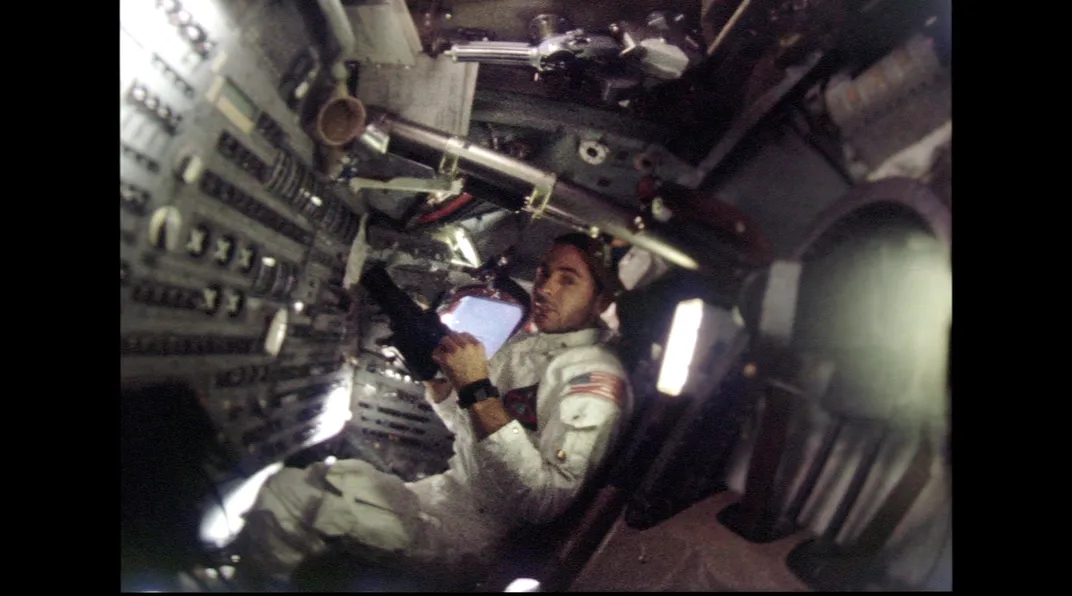
About a week after the video’s release Bill Anders came to Goddard at the invitation of LRO scientist Jim Rice. Wright had already heard that Anders was skeptical he could accurately recreate the Earthrise, but at his computer, Wright showed Anders how he could move a virtual camera along Apollo 8’s orbit and see the Earth rising. The LRO data made Wright’s re-creation of the lunar terrain so accurate that you could superimpose the real Earthrise photo over the simulation and hardly see any difference. Anders turned to Wright and said, “Your picture is better than mine.”
After Anders’ visit Wright felt compelled to take his Earthrise reconstruction to the next level. “Now I was holding some tiny piece of Bill Anders’ legacy in my hand too,” he recalls. He decided to do a full re-creation, one that would show not only Apollo 8’s flight path but also which of the craft’s five windows was turned toward the rising Earth, and as a consequence, who took the pictures.
**********
Even before I first met Wright in May 2012, he had been coming around to my point of view. He’d listened to a digitally cleaned-up copy of the onboard voice tape, and he’d actually heard the sounds of the Hasselblad camera snapping each of the three Earthrise pictures—at just the times that would have fit if Anders had been the photographer on all three images. “After listening to this,” Wright wrote to Jim Rice, “I’m leaning toward Chaikin’s interpretation, which is that Bill took all three photos.” Meeting him, I also noted that less than a minute before the Earth appeared on the horizon, Frank Borman had been occupied with steering the spacecraft through a 180-degree spin.
A year went by with little progress, but in May 2013 Wright emailed me, “I think I have new evidence that Bill Anders took all three Earthrise photos.” On a website called the Apollo Flight Journal, created by historians David Woods and Frank O’Brien, he’d found a set of pictures taken by another camera, operating on a timer, during the first Earthrise. When Wright used his animation software to match Apollo 8’s orientation to each photo, he realized something remarkable: The spacecraft was pointed nose-down at the Moon and was still rotating under Borman’s command when the Earth appeared. At any given moment, only one side of the turning spacecraft was facing the Earth.
But which side? Wright calculated camera angles and window fields-of-view, then simulated the view through each window of the turning spacecraft as it moved in its orbit. Suddenly, he had the clincher: When it first came up, the Earth was visible only through Anders’ side window—and you had to have your nose almost up to the glass to see it.
By the fall of 2013 Wright and colleague Dan Gallagher had produced a new video, synchronized with the onboard voice tape. It reconstructed the historic moment in a way no one except the astronauts had previously experienced. But Wright got an email from an official at NASA headquarters saying, “before you call Frank Borman a liar (which is exactly what you will be doing) I hope that you would have iron-clad evidence to prove your point.” Wright responded with a full accounting of his findings and what they meant. “I don’t think the astronauts lied,” he wrote. “I think they were three overworked, sleep-deprived guys on a dangerous and entirely unprecedented journey. It shouldn’t surprise anyone that they might misremember details about things that weren’t vital to the mission.”
When the new video was posted in time for the 45th anniversary of the Earthrise in December 2013, with my narration, I felt a sense of completion, and admiration for the work that Wright had done. I’ve been glad to hear the astronauts like it too, but I must disclose that the joke is alive and well. A few months ago, when my wife emailed Borman a photo I’d taken of last summer’s total solar eclipse, Borman wrote back, “Great picture, but Anders just called and said he took it!”
A Note to our Readers
Smithsonian magazine participates in affiliate link advertising programs. If you purchase an item through these links, we receive a commission.
